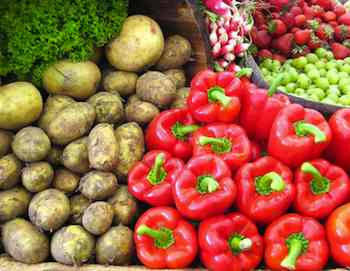- MENU
- HOME
- SEARCH
- WORLD
- MAIN
- AFRICA
- ASIA
- BALKANS
- EUROPE
- LATIN AMERICA
- MIDDLE EAST
- United Kingdom
- United States
- Argentina
- Australia
- Austria
- Benelux
- Brazil
- Canada
- China
- France
- Germany
- Greece
- Hungary
- India
- Indonesia
- Ireland
- Israel
- Italy
- Japan
- Korea
- Mexico
- New Zealand
- Pakistan
- Philippines
- Poland
- Russia
- South Africa
- Spain
- Taiwan
- Turkey
- USA
- BUSINESS
- WEALTH
- STOCKS
- TECH
- HEALTH
- LIFESTYLE
- ENTERTAINMENT
- SPORTS
- RSS
- iHaveNet.com: Health
Rosel Kim

Ever wondered what goes behind the little "certified organic" label on what you eat? Organic certification is a complex process involving many agencies to ensure that you get the difference in quality.
Who decides what's organic?
All the products labeled "organic" in the United States are certified by the
The actual certification process is handled by third-party accredited certifying agents, whose company must demonstrate they can follow and adopt NOP's guidelines.
What does it mean to be organic?
The criteria for organic produce and livestock are rigorous. In order to have produce certified "organic," the grower must not have used any conventional pesticides, petroleum-based fertilizers, or sewage sludge-based fertilizers. Organic livestock must be fed only with organic feed and have regular access to the outdoors. Genetically-modified foods and ionizing radiation are not allowed in any part of production or transportation of the ingredients.
There are also different labeling standards for the different levels of organic commitment from the growers. Products labeled "organic" must have at least 95 percent organic content. Processed foods that display a label "made with organic ingredients" must have 70 percent or more organic content.
One thing to watch out for is the list of "synthetic" (man-made) materials that may make their way into organic production. The NOSB technically prohibits the use of synthetic materials such as: magnesium silicate (concerns about asbestos) and ammonium phosphates. However, it has made exceptions to allow use of synthetic substances such as: chlorine for sanitizing outside contact surfaces (however, the level cannot go over the amount specified by the Safe Drinking Water Act), ethylene for postharvest ripening of tropical fruits, as well as nutrient vitamins for fortification. A study of workers exposed to ethylene on a daily basis suggests prolonged exposure may lead to increased cancer mortality rate.
Afraid that you can't trust the organic label? The USDA can fine up to
How does the organic labeling process work?
In order to qualify for the organic label, the grower applies to the accredited third-party agency with an "organic system plan," including a detailed list of substances used for production, record-keeping procedures, and plans to keep organic and non-organic products separate, if the grower produces any non-organic materials on the farm.
An on-site inspection follows. The certifying agent reviews information submitted by both the grower and the inspector to make sure that the grower meets sufficient standards for organic certification before granting the organic label. After the certification, there are annual follow-up inspections of farms in order to ensure that the grower is consistently following the NOP guidelines.
The same standards apply to imported goods--the USDA does not accept certified organic labels from any other countries or agencies except from their accredited agencies. If a foreign grower wants to have his/her produce labeled organic, the grower must apply for the label through USDA-approved agencies.
However, the U.S. government has recently made "equivalency agreements" with certain foreign governments and their organic certification standards. Products labeled "organic" in Denmark, India, Israel, Japan, New Zealand, and the United Kingdom do not need to go through the U.S. certification process.
When buying organic food, look for the USDA label, which signifies that the food in front of you is made with 95 percent or more organic ingredients. Make sure to check the country of origin and try to buy local as much as possible--the more the produce travels, the more synthetic preservatives may find their way to them.
Rosel Kim is Naturally Savvy' s Eco-Conscious and Organic Living Expert.
Available at Amazon.com:
The Paleo Diet: Lose Weight and Get Healthy by Eating the Food You Were Designed to Eat
The Paleo Diet for Athletes: A Nutritional Formula for Peak Athletic Performance
© Naturally Savvy
AGING | ALTERNATIVE | AILMENTS | DRUGS | FITNESS | GENETICS | CHILDREN'S | MEN'S | WOMEN'S
Health - Decoding Organic Labeling